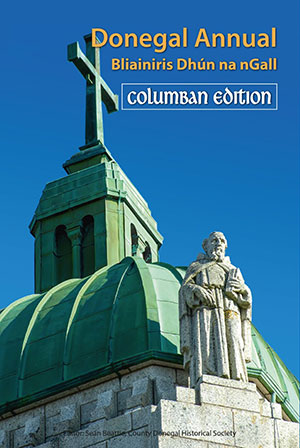 Seán Beattie (ed.)
Seán Beattie (ed.)
Donegal Historical Society
€30
ISSN 041627732021
Reviewed by Matthew Stout
The editor of the Donegal Annual had a hard act to follow in 2021. In 797, for the bicentennial of Colum Cille’s death, the monks of Iona created what later became known as the Book of Kells. Now, for the 1,500th anniversary of Colum Cille’s birth in 621, editor Seán Beattie has assembled a new volume in the saint’s honour. While this may not be the Book of Kells, it is an engaging collection of writings about the county’s most illustrious son.
The two principal themes in this collection concern place and commemoration. The opening paper by Brian Lacy explores the traditions linking Colum Cille with Gartan and Kilmaccrennan (the area between Letterkenny and the Glenveigh National Park). The source for these associations is a 1532 ‘life’ of the saint. Lacy maintains that the locations of the stories about Colum Cille conformed to a chronological and geographical sequence permitting an actual itinerary that would have made this region of Donegal ‘a pilgrimage destination’ (p. 11) in the late Middle Ages. Unfortunately, there are no maps illustrating this route, which would have been of great benefit in an otherwise detailed and insightful study (maps are conspicuously absent in these geographical studies).
In a similar vein, Helen Meehan looks at associations between the saint and the ‘Donegal Bay area’. Pierce Ferriter examines Columban sites in Drumhone, and his paper highlights the valuable work carried out by the Disert Heritage Group with the encouragement of the Heritage Council. Further west and north, Lochlann McGill questions the associations between Colum Cille and Glencolmcille; Vincent O’Donnel looks at Columban traditions associated with Gweebarra Bay; and Seasamh Ó Ceallaigh examines associations between the saint in northern Donegal and Tory Island.
The second main theme of this collection examines how Colum Cille has been celebrated in his home county over the past centuries. Raymond Blair has a short but fascinating piece on Cornelia Adair’s ‘special interest’ (p. 27) in the Columban cult. Cornelia was the widow of the notorious John George Adair and there are echoes here of Lady Gregory’s engagement with the folklore of her own locality. Cornelia put up statues, crosses and stained-glass windows to honour the saint. Blair points out that she took ‘a deep interest’ in the ceremonies at Gartan held to commemorate the 1,300th anniversary of Colum Cille’s death.
This commemoration is the subject of Nollaig MacCongáil’s paper. Over 7,000 attended the Gartan Festival of 9 June 1897. It was very much regarded as part of the Gaelic language and independence movements. The telegraph office had to employ a native speaker from County Clare to handle the flood of communications in Irish.
In 1963 the Church of Ireland held its own ‘large-scale celebration’ (p. 105) of the 1,400th anniversary of Colum Cille’s departure for Iona (in 563). On this occasion, an open-air service at Garton was attended by 10,000 people, and the author, Canon David Crooks, presents a charming personal reminiscence of the commemoration. What conceivable event today could attract that many Protestants to a field in Donegal? How much has Ireland changed in under 60 years? This account by Crooks is significant for the light it sheds on the vast transformations that have occurred in recent Irish history. The Church of Ireland also financed the construction of a curragh that sailed in that year from Derry to Iona. This pre-Brendan Voyage voyage is detailed in an article by Seán Bonner.
Other, shorter pieces explore further tributes to the memory of Colum Cille. Seán Boner writes on Harry Clarke’s depiction of the saint in the stained-glass window in Mount St Joseph’s Abbey near Roscrea. William Roulston provides an account of the plantation church built in Londonderry but nonetheless dedicated to Colum Cille, justified in 1635 because he was the ‘first planter of faith in those parts’ (p. 118). Homage of a different kind is detailed in a delightful paper by Seán Beattie that examines how Colum Cille played a major part in the poetic imagination of Seamus Heaney. A lesser-known connection is that between James Joyce and Colum Cille. There are numerous references to the saint in Finnegans Wake (Calomnequiller, Colunnfiller, Columsisle, Columkiller Columbkisses) and Donal Manning establishes that Joyce owed much to the originator of the Irish concept of ‘silence, exile, and cunning’.
Three further articles address broader historical issues. Tomás G. Ó Canann writes about the role of Columban sites in Derry and Donegal in preserving the pedigrees of the Cenél Conaill. This study could have offered the reader a greater sense of how the Cenél Conaill dynasties can be understood through these genealogical sources, but it is an accomplished piece of historiographical research. Darren McGettigan examines the Viking attacks on Iona and other Columban churches. Max Adams examines the dual role of Columban monastic sites as both ecclesiastical centres and the lords of vast estates.
While it is difficult to sum up such varied scholarship, one thing that emerges from all these essays is a real respect and admiration for a man who lived a very long time ago. Warmth and admiration pour off the pages of this volume. Whether or not the stories about him are true, and however much one could question the associations between Donegal and Colm Cille, those traditions keep his memory alive. In the era of ‘Love Island’ and ‘Gogglebox’ it is nice to be reminded of an alternative life of scholarship and service.
Matthew Stout formerly lectured in the School of History and Geography, Dublin City University.
